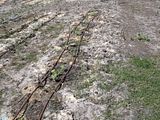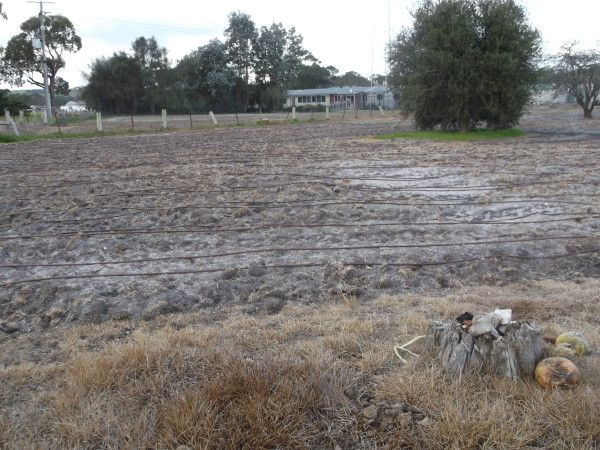|
|
Post by johninfla on Apr 1, 2016 6:35:04 GMT -5
Good Morning folks,
I have been using permanent drip irrigation with my fruit trees for several years now but this year I bought a roll of drip tape and am going to try it with my corn. I bought a fairly cheap ($39) 1000 foot roll (it's 8 mil) to try. I have a disc filter (150 mesh) on my supply line so I think I'll be good there. I'm thinking 8 mil may be too light to last more than one year but since this is more or less an experiment I'm prepared to sacrifice it this year. I know that a lot of you folks in the more arid areas probably use drip all the time, so I'm wondering just what advice you could give me.
Thanks
John
|
|
|
|
Post by rowan on Apr 1, 2016 14:25:35 GMT -5
I am so glad I moved to drip. I looked into the tape but it was far too much hassle so I got the more expensive inline drip tube, I am so pleased I did. A dripper system means the water is going exactly where you want it and not being wasted on bare ground and weeds.
|
|
|
|
Post by steev on Apr 1, 2016 23:08:01 GMT -5
I also use inline drip; I only use inserted drippers where plants are widely-spaced, like trees; always thought the tape or weeper-hose too temporary/flimsy.
I like that I can throw my drip-lines off the beds for tilling and connect more/fewer lengths, or lengths of differently-spaced drippers, to suit what I'm growing.
I always mulch over my lines and beds for water-conservation, weed abatement, and eventual soil amendment.
|
|
|
|
Post by johninfla on Apr 2, 2016 7:45:42 GMT -5
I hadn't thought about the inline drip. The melon farmers around here use tape, so it wasn't in my mindset.  Do you use the 1/4 drip tube? How long of runs can you make with them? I like the idea of something more permanent. John |
|
|
|
Post by rowan on Apr 2, 2016 14:23:07 GMT -5
I have three acres under inline drip tubing with drips every 30cm. Each section of drip line has to be under 50m (150 feet) to keep up pressure to all beds but I run 25mm (1 inch) mainlines down each row of beds with drip tube coming off to each 20m bed like a grid. Each line will do 1/3 acre but since each mainline is more than that I have taps on each bed so I can stop water on which ever beds don't need it, or just do half a line at a time. There are three way valve taps at the start of the rows so I can move the water to the rows I want. I really hope this makes sense  For smaller areas this would be much simpler. Like Steev says this drip tube is more permanent and you can throw them off each bed when you are digging or mulching them. I have been using this system for a year now and am very happy with it and will be putting my whole ten acres under it as I can afford it.  
|
|
|
|
Post by philagardener on Apr 2, 2016 20:14:51 GMT -5
Wow, rowan , is that typical SH winter and/or are you really dry right now? |
|
|
|
Post by rowan on Apr 2, 2016 22:21:54 GMT -5
I am in Australia so have just finished summer, and we are in a severe drought right now also.
|
|
|
|
Post by steev on Apr 3, 2016 21:21:55 GMT -5
Commercial farmers commonly discard their field-drip lines, rather than going to the trouble of removing and re-deploying them, so whatever is cheapest that will serve until they need to re-work the field is how they go.
I have some lines I've been using a decade. I like to mulch over lines for UV protection and to avoid parboiling plants (learned that the hard way). I have in-ground PVC tube to valves and above-ground outlets to which I connect 100' lengths of inline tubing, fitted with female/male hose adapters, adding as many lengths as is appropriate for the planting. I never have to coil the tubes (a totally PITA kink-fest) since I just throw them into the parallel tree-lanes when I till, still stretched along the planting-lane. Since I use in-line drip tube, they can stay there for months and still be easily stripped out of the weeds, having nothing to catch, like inserted drippers.
The tube I use is a bit over half-inch; the 1/4" in-line I only use in very limited places, as I would an inserted dripper.
|
|
|
|
Post by philagardener on Apr 4, 2016 8:49:08 GMT -5
I am in Australia so have just finished summer, and we are in a severe drought right now also. I was surprised how empty and dry your field looked! Hope you recharge in the off season! |
|
|
|
Post by rowan on Apr 4, 2016 14:19:33 GMT -5
We haven't had rain for two years so I am really hoping we get some this coming winter and spring to fill the subsoil
|
|
|
|
Post by littleminnie on Apr 5, 2016 20:24:30 GMT -5
I really hate the 8 mil tape. I will always get 10 mil or above for more seasons. 8 mil is very hard to connect because it is so thin.
Also you need a filter, anti suction device and pressure regulator. I use 3/4 inch tubing and tubing fittings for the mainline.
|
|
|
|
Post by richardw on Apr 5, 2016 20:44:15 GMT -5
I'm thinking of putting my firewood block of Eucalyptus on a drip system because the growth is so slow, its just too dry here for them with out watering. Would like to have it where i can roll up at the end of each summer to the end where the main feeder pipe is, that way it wont disappear into the long grass. These Eucalyptus are 12 years old, if they had been on drip from the start they would have been 3X the size by now  |
|
|
|
Post by steev on Apr 5, 2016 21:11:30 GMT -5
It may look more economical to go with cheaper, but how long do you plan to be in the game? Today's hard bite can save many annual nibbles. It's like hand tools: the ones made in China from recycled gum-wrappers are cheap, but they just don't last like the ones made in Japan of quality steel. Quality irrigation materials of serious size are initially spendy, but they don't trap you in a cycle of repeated expense. Building anything, even an irrigation system, to the bare minimum is penny-wise, but pound-foolish. It's not just the cost of the materials; what about your time/effort to repeatedly deal with cheesy crap?
I kid you not; my riega is heirloom quality, not so much for passing down, but so I don't have to mess with it in my declining years; that it will serve my posterity is lagniappe; I'm serving my own aging ass.
Re eucs: ick! Those that were planted in the Bay Area after cutting all the native redwood are slowly being eradicated, which is good. They were touted as timber for lumber, but they weren't good for that, being too twisty-grained; the full ecosystem needed to re-cycle their detritus was not established, so they just became a serious fire-threat. As firewood, I like the blue euc, although it takes half again as long as oak to dry enough so it doesn't crap up the flue.
I will note that the eucs planted on the previously-denuded East Bay (post 1906 earthquake/fire) hills catch fog all Summer, raining it to feed springs that flow to the bay, very valuable, but better done by native coast redwoods, whose detritus is processed by the local biota, preventing its build-up as such a fire-resource. It might seem that we, in NorCal, are a tad stuck on issues of fire, but having a Mediterranean climate (getting drier with global climate change), fire is an annual concern for us; it threatens our land, homes, and air (great sunsets, though, provided one still has a porch from which to view them).
|
|
|
|
Post by rowan on Apr 5, 2016 22:28:13 GMT -5
I suppose that when you grow up with Eucs as our main native trees we learn to deal with them as firewood and the annual fire risk, it is all we know and live with so it is hard to imagine the hatred some people in other parts of the world fee  We in Aus won't touch imported species as firewood as it burns so quickly and some gum up the flues. The detritus that gums leave on the floor is part of our landscape and what we are used to. |
|
|
|
Post by steev on Apr 5, 2016 23:34:37 GMT -5
I assure you I have no problem with eucs as such; nor have I any grasp of why they would be hated; it's just that they are poorly integrated into our ecosystem and drop a lot of oily detritus that the local biome can't process well, leading to the build-up of considerable extremely flammable debris.
Here in the Bay Area, they are being replaced by oaks/redwoods, which they replaced earlier, which do not build up quantities of flammable, unbroken-down detritus, thanks to the local biome. I support this because I've seen devastating fire that took 1000+ homes off the hills (it took two photos to get the full scope; dropped ash in my yard all day, while my daughter and her friend were playing, as well as across the bay to SF).
There's something about an ash-page of a cook-book falling into one's yard to put one off wildfire; I really don't care what kind of trees were exploding into flame that day; I just want it to never happen again.
|
|